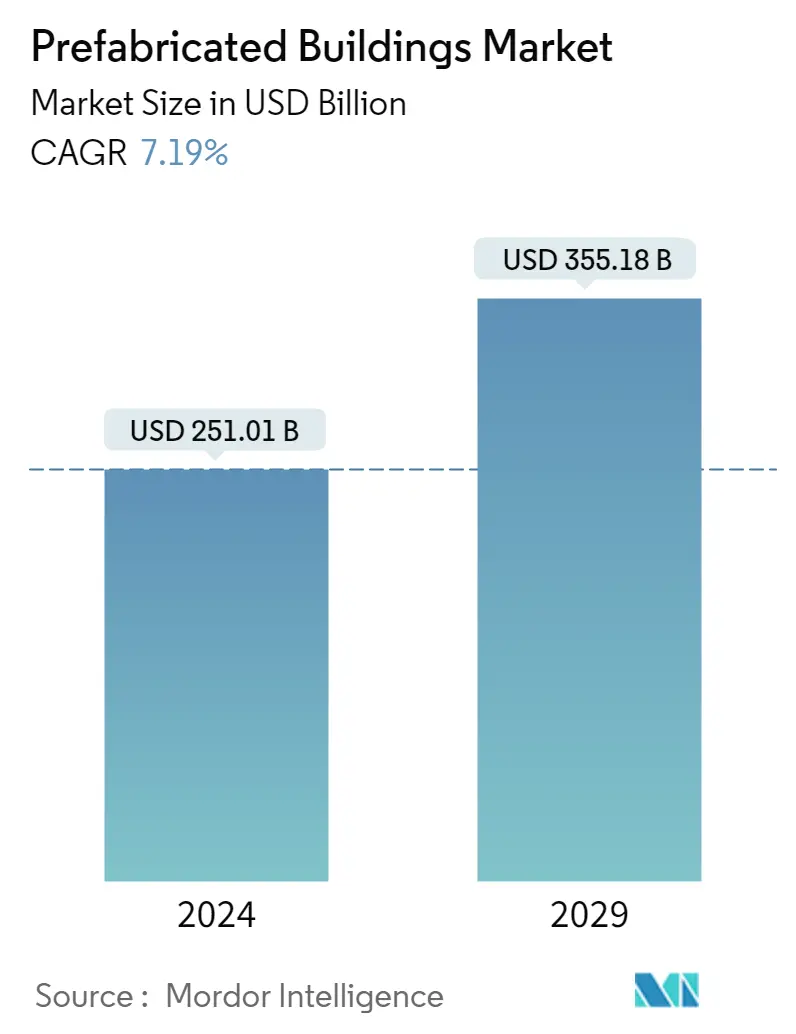Market Size of Prefabricated Buildings Industry

| Study Period | 2020 - 2029 |
| Market Size (2024) | USD 251.01 Billion |
| Market Size (2029) | USD 355.18 Billion |
| CAGR (2024 - 2029) | 7.19 % |
| Fastest Growing Market | Asia-Pacific |
| Largest Market | North America |
Major Players
*Disclaimer: Major Players sorted in no particular order |
Prefabricated Buildings Market Analysis
The Prefabricated Buildings Market size is estimated at USD 251.01 billion in 2024, and is expected to reach USD 355.18 billion by 2029, growing at a CAGR of 7.19% during the forecast period (2024-2029).
All construction-related operations worldwide stopped due to the COVID-19 pandemic and consequent lockdowns. As a result, modular construction projects in various construction segments, such as educational, residential, airports, and others, had decreased, thus significantly impacting demand for prefabricated buildings. In several places, the supply chain had also been interrupted, thus causing a delay in the delivery of construction material required and affecting the construction activities.
The adoption of additive manufacturing in Europe is expected to significantly boost the prefabricated construction sector. Companies are embracing eco-friendly products and production practices to set themselves apart from the competition. The introduction of energy-absorbing materials such as micro dwellings resulted from the focus on energy efficiency.
Another major factor driving market expansion in the region, particularly in Switzerland, the Nordics, and the United Kingdom, is the introduction of turnkey solutions. Germany, the Nordic countries, and the United Kingdom dominate the prefabricated building industry in Europe.
The United Kingdom is a prospective market for prefabricated building companies. The major players are investing in improved performance and productivity to capitalize on the market's growth potential and modular construction approaches. The existing shortage of skilled labor in the construction industry is a crucial element sustaining the United Kingdom's position in the European prefabricated building industry.
Prefab enterprises have a huge opportunity in India, where there is a need for hundreds or thousands more plants in the future. India is anticipated to be among the fastest-growing countries in terms of construction output over the next few years, making technology a critical component.
India is projected to be the world's second-largest building market in the next five years. A continued government push for digitalization and the adoption of cutting-edge construction technology like BIM is a key driver for the adoption of prefabricated buildings. Government efforts such as "Digital India," "Housing for All," and "Bharatmala Pariyojana" have boosted the use of prefabricated buildings in India.
The value of prefabricated buildings imported into Spain increased significantly in 2022. From 2003 to 2007, the imports of these products increased until they were valued at EUR 101 million(USD 109.78 Million). After that, those imports had a downward trend, reaching EUR 36 million(USD 39.13 Million) in 2012. The prefabricated buildings imported in 2021 into Spain were valued at EUR 65 million(USD 70.65 Million).
Prefabricated Buildings Industry Segmentation
A prefabricated building is a building or part of a building that has been manufactured in advance and can be easily transported and assembled.
The prefabricated buildings market is segmented by material type (concrete, glass, metal, timber, and other material types), application (residential, commercial, and industrial), and geography (North America, Europe, Asia-Pacific, and the Rest of the World).
The report offers market size and forecast in (USD) for the segments mentioned above.
| By Material | |
| Concrete | |
| Glass | |
| Metal | |
| Timber | |
| Other Materials |
| By Application | |
| Residential | |
| Commercial | |
| Industrial |
| By Region | ||||||||||
| ||||||||||
| ||||||||||
| ||||||||||
| Rest of the World |
Prefabricated Buildings Market Size Summary
The prefabricated buildings market is poised for significant growth, driven by advancements in construction technology and increasing demand for efficient building solutions. The market is experiencing a resurgence as countries worldwide recover from the disruptions caused by the COVID-19 pandemic, which had previously halted construction activities and disrupted supply chains. The adoption of eco-friendly practices and energy-efficient materials is gaining traction, particularly in Europe, where countries like Germany, the Nordics, and the United Kingdom are leading the charge. The introduction of turnkey solutions and the integration of additive manufacturing are further propelling the market forward. In regions such as India, the push for digitalization and government initiatives like "Digital India" are fostering the growth of prefabricated buildings, positioning the country as a rapidly expanding market for construction technology.
Globally, the demand for prefabricated buildings is being fueled by urbanization, economic development, and government investments in infrastructure. The Asia-Pacific region, with its burgeoning construction activity, is expected to witness the highest growth, driven by the need for affordable housing and rapid urbanization. Countries like Singapore and India are making substantial investments in their construction sectors, while the Dutch government's circular economy initiative is boosting the industry. The prefabricated building system offers numerous advantages, including reduced construction time, cost savings, and minimal on-site disruption, making it an attractive option for both residential and non-residential projects. As the market continues to expand, major players such as Clayton Homes, Sekisui Homes, and Barratt Developments PLC are capitalizing on the growing demand, contributing to the fragmented yet dynamic nature of the industry.
Prefabricated Buildings Market Size - Table of Contents
-
1. MARKET INSIGHTS AND DYNAMICS
-
1.1 Current Market Scenario
-
1.2 Market Dynamics
-
1.2.1 Drivers
-
1.2.1.1 Growing demand for Modular Construction
-
1.2.1.2 Asia-Pacific is Projected to Witness Highest Growth in the Market
-
-
1.2.2 Restraints
-
1.2.2.1 Lack of awareness and acceptance of of prefabricated buildings among consumers and builders
-
1.2.2.2 Higher transportation and logistics costs associated with the prefabricated buildings
-
-
1.2.3 Opportunities
-
1.2.3.1 Increasing demand for sustainable and eco-friendly building practices
-
1.2.3.2 Prefabricated buildings can be designed to be energy - efficient and environmentally friendly
-
-
-
1.3 Industry Attractiveness - Porter's Five Forces Analysis
-
1.3.1 Bargaining Power of Suppliers
-
1.3.2 Bargaining Power of Buyers/Consumers
-
1.3.3 Threat of New Entrants
-
1.3.4 Threat of Substitute Products
-
1.3.5 Intensity of Competitive Rivalry
-
-
1.4 Value Chain/Supply Chain Analysis
-
1.5 Government Regulations
-
1.6 Technological Developments
-
1.7 Brief on Different Structures Used in the Prefabricated Buildings Industry
-
1.8 Cost Structure Analysis of the Prefabricated Buildings Industry
-
1.9 Impact of COVID-19 on the market
-
-
2. MARKET SEGMENTATION
-
2.1 By Material
-
2.1.1 Concrete
-
2.1.2 Glass
-
2.1.3 Metal
-
2.1.4 Timber
-
2.1.5 Other Materials
-
-
2.2 By Application
-
2.2.1 Residential
-
2.2.2 Commercial
-
2.2.3 Industrial
-
-
2.3 By Region
-
2.3.1 North America
-
2.3.1.1 United States
-
2.3.1.2 Canada
-
2.3.1.3 Mexico
-
-
2.3.2 Europe
-
2.3.2.1 Germany
-
2.3.2.2 Italy
-
2.3.2.3 United Kingdom
-
2.3.2.4 Sweden
-
2.3.2.5 Netherlands
-
2.3.2.6 Spain
-
2.3.2.7 Rest of Europe
-
-
2.3.3 Asia-Pacific
-
2.3.3.1 China
-
2.3.3.2 Japan
-
2.3.3.3 India
-
2.3.3.4 Australia
-
2.3.3.5 Indonesia
-
2.3.3.6 Singapore
-
2.3.3.7 Malaysia
-
2.3.3.8 Rest of Asia-Pacific
-
-
2.3.4 Rest of the World
-
-
Prefabricated Buildings Market Size FAQs
How big is the Prefabricated Buildings Market?
The Prefabricated Buildings Market size is expected to reach USD 251.01 billion in 2024 and grow at a CAGR of 7.19% to reach USD 355.18 billion by 2029.
What is the current Prefabricated Buildings Market size?
In 2024, the Prefabricated Buildings Market size is expected to reach USD 251.01 billion.

